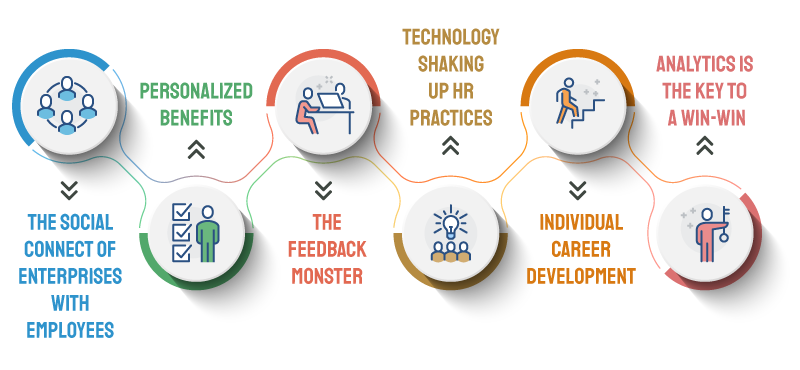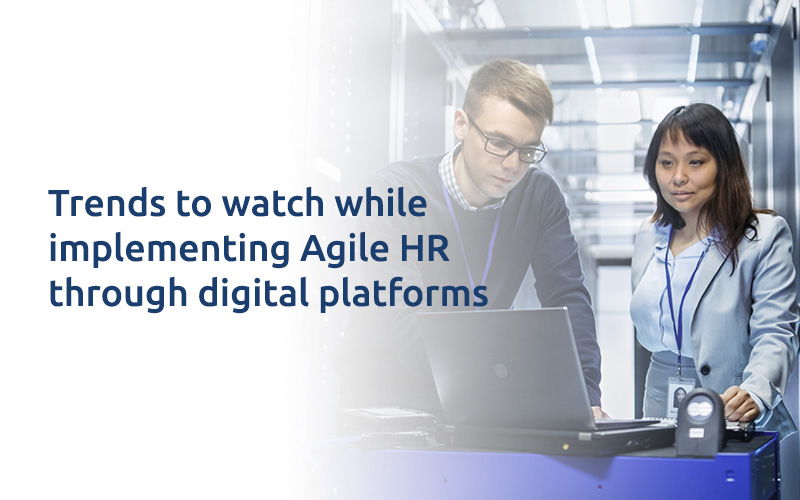
Trends to watch while implementing Agile HR through digital platforms
Human resources (coined in 1960) is department of employees where they connect with activities like motivation,
training, soft skill development, organizational behavior and assessment for self-development. The past decade, has
been harsh on individuals in terms of appraisals and jobs. Human resource department has been under fire due to the
same. But, not for long since the advancements in technology platforms, HR pressure will reduce in the coming
decade. So what is going to change.
As millennials have started working in offices, there has been a growth in the tech savvy index and information
orientation of enterprises. The trend of succession planning (La’-la’ companies) has moved to well-planned future
and talent acquisition. To understand the landscape, some of the trends are as mentioned below

-
The social connect of enterprises with employees
Even after the success of Facebook and twitter, enterprises are hesitant to impart via web-based social
networking. It is still considered as a device of interruption in profitability of brand image. But, because
of increase in mobile utilization, the touch points are simple and therefore, enterprises are moving to more
conveying approach than controlling one. As indicated by study from BambooHR, there is an increase of 30
percent web based life communications from organizations to workers. -
Personalized benefits
Wellness, retirement and education are few of the advantages offered by the enterprises to employees across
the globe. But, as the companies have adopted a head-on strategy, individuals are expecting more
personalized advantages instead of group ones. Organizations are moving towards a methodology where they
offer a specific amount of cash to people which they can choose in the event that they need to move towards
Loans, Care, or anything that goes under the company policy. -
The feedback monster
Probably the biggest fear in the mind of C-suite is the ‘input’ itself. In the event, it is personal it hurts
egos and on social media attracts attention and damages company image. The majority of the enterprises end
up concentrating on compensation as opposed to on feedback mechanism because of absence of appropriate
frameworks and input techniques. Today, organizations are adopting a casual strategy to speak with the
employees. By focusing in the Impact metrics, the performance review of employees is made easy and focus on
work-life balance is considered. -
Technology shaking up HR practices
Digital technologies are changing the paradigm of digital enterprises. From working remote to candidate
pooling, dynamics in a workplace are changing. Due to access to global network, work arrangements and
schedules are becoming flexible. The digital technologies are trying to communicate between these silo
points and bringing in uniformity in organization work policies and not much of a surprise the touch of
human element. -
Individual Career development
A year ago, when we met a specific group, we came to a conclusion that when it comes to developing a company,
a full stack of skill, connect between the CIO and CEOs are needed. This would take the pressure of an
employee to run after the task they are given. Today jack of all trades is one the most important factors
when it comes to hiring. The Millennial workforce which is more focused and intelligent is gearing up for
new experiences in less time. So, Instead of buying loyalty, companies are incentivizing new social
contracts and business paradigms. If the HR teams in organizations become more agile and communicative, they
can create flexibility and save a load of money for the companies. -
Analytics is the key to a win-win
HR managers in medium scale organizations are using metrics to understand their employees, measure costs and
foresee the impact on workforce of trainings. But, still the level of data analyst in the HR workforce is
lacking which has led to 92% negative impact on the employee requirement to solution alone. What’s next in
the coming year then? Even if analytics has had a sluggish start, use of data will lead to biggest
game-changer in hiring, compensation and acquisition. For example, analytics will bring about connect in
character mapping a skill mapping to the requirement of an organization.
Thus, HR would be moving from ‘the police’ to mentors and leaders in the coming trends.
